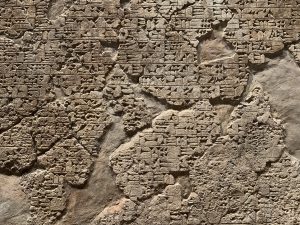Introduction
Assyrian royal inscriptions have always been crucial historical documents for studying the Ancient Near East. These texts usually describe a king's yearly deeds, principally military campaigns that were successful and the construction and renovation of palaces and temples. Because of their 'chronological' arrangement, these sources are also called 'annals' or historical records. The inscriptions were written on various materials and objects, such as stone or clay tablets, decorative wall panels (reliefs), freestanding monuments (e.g., statues and steles), and clay prisms. Assyrian 'annals' date back to 1114 BCE (the reign the Middle Assyrian King Tiglath-Pileser I) and are attested until the end of the Assyrian Empire in 612 BCE.


Detail of an Assyrian inscription written on a wall slab that is currently exhibited in the ISAC museum in Chicago.
Since the rediscovery of Assyria and Babylonia in the 19th century – when the first excavations of the Assyrian palaces and the decipherment of Assyrio-Akkadian cuneiform took place – Assyrian royal inscriptions have been copied, transliterated (the cuneiform transferred into Latin characters), and translated numerous times. Depending on when the text was edited, the published results followed different principles and standards. However, when an international collaboration was founded in the late 1970s in Toronto to edit and translate all Assyrian inscriptions, the texts were transliterated and translated uniformly for the first time. The Royal Inscriptions of Mesopotamia (RIM) Project and its successor, the Royal Inscriptions of the Neo-Assyrian Period (RINAP) Project, established new standards of editing this large and diverse corpus of texts, both using the latest available technology. The result is a series of eleven printed books and an open-access and linguistically-annotated online corpus that has many features that come in handy for specialists and non-specialists who wish to know more about this group of ancient sources.
This e-learning tool will introduce you to the RINAP online corpus and some of its features. You will learn about the advantages and disadvantages of an online corpus compared to a printed version and, more importantly, how to engage critically and directly with the source material. This e-learning tool primarily addresses students of Assyriology, theology, history, and other disciplines, but is not limited to this audience. Even as a specialist in Assyriology, you might find a new feature of the RINAP online corpus that you never knew about.
This e-learning tool includes the following guidelines:
1. Exploring Word Meanings, Translations and Other Instances
2. Searching for Words/Phrases
3. Contextualising the Inscriptions
You can find the Project home page here:
http://oracc.org/rinap/- For the Corpus home page, follow this link:
http://oracc.org/rinap/corpus/
© This online tool, created by Nikola Wenner in consultation with Dr Jamie Novotny and Prof. Dr Karen Radner, is a cooperation between IDK Philology and RINAP Online. It is part of the World Philology e-learning platform of IDK Philology, sponsored by Elite Netzwerk Bayern.




